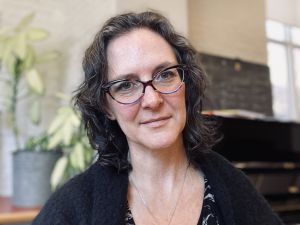
Graduate students, from left: Ann Farrell, Natalie Spadafora and Heather Woods, are participating in an upcoming Research Café panel discussion about bullying.
Three graduate students are part of a strong contingent of researchers across Canada working toward a common goal – to end bullying.
Ann Farrell, a PhD student in Psychology, is examining subtypes of bullying and the factors that influence each subtype.
Natalie Spadafora, a master’s student in Child and Youth Studies, is researching bystander intervention amongst adolescents.
Heather Woods, a master’s student in Education, is studying the confidence and abilities of teachers in intervention programs.
Each student has been awarded a SSHRC graduate scholarship – a signal of the importance their research holds for an issue that impacts the well-being of society – children and adults – on a daily basis.
All of them are participating in an upcoming Research Café panel discussion about bullying.
The panel event is a free public forum.
It will be held at Brock on Friday, Nov. 21, from 1 p.m. to 3 p.m. at the Scotiabank Atrium in the Cairns Family Health and Bioscience Research Complex as part of Bullying Awareness Week in Canada (Nov. 16-22). Please register online to attend.
Marty Mako, a health promoter for Niagara Region Public Health and a member of Brock University President’s Task Force on Community Engagement, will moderate the panel that also includes faculty researchers: Lisa Barrow, Assistant Professor, Goodman School of Business, Zopito Marini, Professor, Child and Youth Studies, and Andrew Dane, Associate Professor, Psychology.
In connection with the panel presentation, Brock Research has produced a podcast that features Barrow and Marini talking about how awareness and understanding of bullying has changed.
As panel members Nov. 21, the graduate students will share details about their research to extend the conversation about the complex issue of bullying in society today.
Ann Farrell’s study, an extension of her master’s research, reveals the underlying complexity of bully behaviour based on the identification of five bullying subtypes – physical, verbal, social, racial, sexual. She works under the supervision of Associate Professor Tony Volk.
Farrell says that each subtype is influenced by individual factors, such as personality, temperament, sex, and age, as well as ecological factors, such as parental monitoring, parent support, school connectedness, peer relationships, and friendship quality.
Her project will be a component of a larger, long-term research study led by Volk.
Her component will be to help determine what combination of individual factors and ecological factors predict the five subtypes of bullying.
“By measuring the bullying subtypes in relation to individual and ecological factors, I hope that the research will help determine specific intervention and prevention strategies for each subtype,” says Farrell.
As part of the larger research study with Volk, Farrell will help recruit at least 300 adolescents (12 to 16 years) through extra-curricular clubs in southern Ontario to participate in her study.
Once a year for three years the study participants will be asked to respond to self-report questionnaires about interactions with peers.
Natalie Spadafora will be working with a similar age group to look at bystander intervention.
As part of her undergraduate research in the Child and Youth Department, Spadafora examined bullying within the context of sports, examining variables such as temperament, incivility and antisociality in relation to bullying behaviours.
Continuing under the supervision of Marini for her master’s research, Spadafora will continue to study bullying, through an examination of the role of the bystander in bullying situations.
Through her practical experience with children and youth, Spadafora understands the prevalence of this social dynamic.
“Adolescents are being taught the negative aspects of bullying, and are aware that they should intervene if given the opportunity,” she says. “However, research has found that as youth get older, they tend to intervene less and less. My study will examine predictors of bystander intervention. As well, I plan to use a cost/benefit framework through an evolutionary perspective in order to more closely examine the decision-making process and motivations of adolescents when choosing to intervene or not when witnessing a bullying situation.”
Heather Woods will reach out to teachers at all grade levels with questionnaires about teachers’ confidence in implementing anti-bullying programs. Her master’s research is supervised by Education Professor Sandra Bosacki.
“School boards have attempted to address bullying within the schools, however despite their widespread implementation, many school-based bullying interventions have not shown a significant decrease in bullying statistics,” says Woods. “Teachers may be the first line of defence against bullying within the classroom, and their beliefs about bullying, along with their confidence in intervening need to be taken into consideration.”
The study will take into account teachers’ beliefs about and their confidence to intervene in various types of bullying situations, including physical, relational, verbal bullying and cyberbullying.
Through the questionnaire, Woods also plans to explore teachers’ beliefs about bullying, their own confidence beliefs, current anti-bullying initiatives, and recommendations for improvement of anti-bullying programs and teacher training.
“The goal of the current research is to provide a strong voice for teachers regarding bullying, and allow for further development of more successful anti-bullying programs,” she says. “This in turn could allow for stronger teacher training by shedding light on teachers’ needs.”










